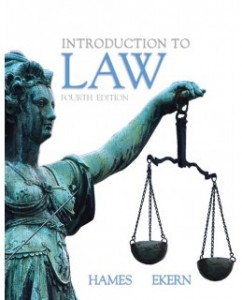Test Bank for Introduction to Law, 4th Edition: Joanne B. Hames
$35.00 Original price was: $35.00.$26.50Current price is: $26.50.
Test Bank for Introduction to Law, 4th Edition: Joanne B. Hames
Instant download Test Bank for Introduction to Law, 4th Edition: Joanne B. Hames pdf docx epub after payment.

Product details:
- ISBN-10 : 013502434X
- ISBN-13 : 978-0135024348
- Author: Joanne B. Hames; Yvonne Ekern
Hames and Ekern’s Introduction to Law , 4/e will teach students the basic legal concepts related to substantive and procedural law, introduces them to cases, statutes, and the constitution, and develops their legal vocabulary and analytical skills. A new chapter on constitutional law, expanded coverage of employment and environmental law, and information on technology makes this an excellent resource for any Introduction to Law course for all disciplines of study including pre-law, legal studies, and business programs. Using this text, your students will learn how to develop their own critical-thinking skills, read high-interest cases, expand their legal vocabulary and discuss case law and issues impacting today’s legal system.
Table of contents:
PART ONE THE LEGAL SYSTEM
Introduction to Law
1(14)
Chapter Objectives
1(1)
Case File: Centerville News: March 10
1(1)
Introduction
2(1)
What Law Is
2(3)
Historical Origins
2(1)
Philosophical Theories
3(1)
Case Summary: Exxon Shipping Co. v. Baker
4(1)
Categories of Law
5(10)
Source of Law
5(1)
Substantive and Procedural Laws
5(1)
Criminal and Civil Laws
6(1)
Substantive Criminal and Civil Laws
6(1)
Criminal and Civil Procedures
7(1)
Case Summary: People v. Sirhan Sirhan
7(1)
Case Summary: Marshall v. Marshall
8(1)
Court Procedures
8(2)
Chapter Case: Roper v. Simmons
10(2)
Technology Corner
12(1)
Sites of Interest
12(1)
Featured Web Site
12(1)
Around the World
12(1)
Chapter Summary
13(1)
Terms to Remember
13(1)
Questions for Review
13(1)
Application and Analysis Problems
14(1)
Assignments and Projects
14(1)
Skills Assessment
14(1)
The U.S. Legal System
15(20)
Chapter Objectives
15(1)
Case File: The Rambeaux Matters
15(1)
Introduction
16(1)
Federalism—The Relationship Between Federal and State Government
16(6)
Powers of the Federal Government
16(1)
Case Summary: United States v. Lopez
17(1)
Chapter Case: Katzenbach v. McClung
17(2)
Powers of the State Government
19(1)
Exclusive and Concurrent Powers of Federal and State Governments
19(1)
Conflicts Between Federal and State Law—The Supremacy Clause
20(1)
Chapter Case: Texas v. Johnson
20(2)
The Supremacy Clause and the Bill of Rights
22(1)
The Federal Government and the Legal System
22(1)
Executive Branch
22(1)
Legislative Branch
23(1)
Judicial Branch
23(1)
State Governments and the Legal System
23(1)
Case Summary: Heath v. Alabama
23(1)
Local Governments
24(1)
Sources of U.S. Law
24(11)
Constitutional Law
25(1)
The Federal Constitution
25(1)
State Constitutions
26(1)
Case Law
26(1)
Case Law—The Factual Controversy
26(1)
Case Law—Interpretation of Constitutional and Statutory Law
26(1)
Case Summary: PGA Tour, Inc. v. Martin
27(1)
Case Summary: District of Columbia v. Heller
28(1)
Case Summary: Tennessee v. Garner
28(1)
Case Law—The Power to Invalidate Statutory Law
28(1)
Case Law—Stare Decisis Today
29(1)
Case Summary: Ohio v. Robinette
29(1)
Case Summary: State v. Robinette
29(1)
Statutory Law
30(1)
The Legislative Process—The Federal Government
31(1)
The Legislative Process—State Governments
31(1)
Publication of Statutory Law
32(1)
Administrative Regulations
32(1)
Technology Corner
32(1)
Sites of Interest
32(1)
Featured Web Site
32(1)
Around the World
32(1)
Chapter Summary
33(1)
Terms to Remember
33(1)
Questions for Review
33(1)
Application and Analysis Problems
33(1)
Assignments and Projects
34(1)
Skills Assessment
34(1)
The Courts and Legal Personnel
35(28)
Chapter Objectives
35(1)
Case File: Eberhardt Matter
35(1)
The Courts and Their Roles
36(8)
The Federal Court System
36(1)
Federal District Courts
36(1)
Structure
36(1)
Function and Jurisdiction
36(3)
Special Trial Courts
39(1)
Federal Appellate Courts
39(1)
Structure
39(1)
Function and Jurisdiction
39(1)
The U.S. Supreme Court
40(1)
Structure
40(1)
Function and Jurisdiction
41(1)
Case Summary: Philip Morris USA v. Williams
41(2)
The Courts and Technology
43(1)
State Court Systems
44(1)
The Judiciary
44(1)
Federal Judges
44(1)
State Court Judges
45(1)
The Legal Community
45(4)
Court Personnel
45(1)
Lawyers
45(1)
Paralegals
46(1)
Legal Support Staff
46(1)
Agency Personnel
47(1)
The Criminal Justice Field
48(1)
Professional Organizations
48(1)
American Bar Association (ABA)
48(1)
State Bar Associations
48(1)
Local Bar Associations
48(1)
American Trial Lawyers Association (ATLA)
49(1)
National Association of Legal Assistants (NALA)
49(1)
National Federation of Paralegal Associations (NFPA)
49(1)
American Association for Paralegal Education (AAfPE)
49(1)
Ethics and Professional Conduct
49(14)
Judicial Ethics: Judges and Judicial Employees
49(4)
Legal Ethics: Lawyers and Paralegals
53(1)
Confidentiality
53(1)
Competency
54(1)
Conflict of Interest
54(1)
Case Summary: Phoenix Founders, Inc. v. McClellan
55(1)
Attorney Fees and Trust Accounts
55(1)
Communication with Opposing Parties
56(1)
Unauthorized Practice of Law
56(1)
Chapter Case: The Florida Bar v. Furman
56(1)
Ethical Concerns for Criminal Justice Professionals
57(1)
Chapter Case: Brady v. Maryland
58(1)
Technology Corner
59(1)
Sites of Interest
59(1)
Featured Web Site
59(1)
Around the World
59(1)
Chapter Summary
60(1)
Terms to Remember
60(1)
Questions for Review
60(1)
Application and Analysis Problems
61(1)
Assignments and Projects
62(1)
Skills Assessment
62(1)
Finding the Law: Legal Research
63(20)
Chapter Objectives
63(1)
Case File: The Welch Family Law Matter
63(1)
Introduction
64(1)
Before You Begin
64(3)
Know the Facts
65(1)
Analyze the Facts
65(1)
Identify the Issues
65(1)
Use the Relevant Facts to Define the Issues
65(1)
Sort the Facts
66(1)
Where to Begin the Research
67(4)
Dictionaries
67(1)
Encyclopedias
67(1)
Form Books
67(4)
Legal Periodicals
71(1)
Treatises
71(1)
Digests
71(1)
Case Law
71(8)
What Is a Case?
71(1)
Where to Find Case Law
72(1)
Federal Case Law
72(1)
State Case Law
73(1)
How to Read and Use Case Law
73(4)
Chapter Case: In re Marriage of Modnick
77(1)
Case Summary: Cashing v. Cushing
78(1)
Statutory Law
79(4)
Using Statutory Law
79(1)
Technology Corner
80(1)
Sites of Interest
80(1)
Featured Web Site
80(1)
Around the World
80(1)
Chapter Summary
81(1)
Terms to Remember
81(1)
Questions for Review
81(1)
Application and Analysis Problems
81(1)
Assignments and Projects
82(1)
Skills Assessment
82(1)
Using the Law: Analysis and Legal Writing
83(21)
Chapter Objectives
83(1)
Case File: The Holmes Middle School Law Matter
83(1)
Introduction
84(1)
Approaching a Legal Research, Analysis, and Writing Project
84(6)
Overview
84(1)
Preparing a First Draft
85(1)
Beginning the Writing Process
86(1)
Initial Considerations
86(1)
The Thesis Paragraph
86(1)
Sentences and Paragraphs
87(2)
Editing and Revision Process
89(1)
Keeping Legal Writing Simple
89(1)
Use Short Sentences
89(1)
Use Active Voice
89(1)
Avoid Unnecessary Words
90(1)
Use Specific, Concrete Terms
90(1)
The Case Brief
90(6)
The Components of a Case Brief
90(2)
Chapter Case: Gideon v. Wainwright
92(2)
How to Write a Case Brief
94(1)
Case Summary: Betts v. Brady, 316 U.S. 455 (1942)
95(1)
The Legal Memorandum
96(5)
Writing a Legal Memorandum
96(1)
Statement of Facts
96(1)
Issue Statement
97(1)
Discussion/Analysis
97(1)
Conclusion
97(1)
Citing Authorities
97(1)
Format
97(1)
Using Id
97(1)
Using Quotations
98(2)
Case Summary: United States v. Tarpley
100(1)
Persuasive Writing
101(3)
Technology Corner
102(1)
Sites of Interest
102(1)
Featured Web Site
102(1)
Around the World
102(1)
Chapter Summary
103(1)
Terms to Remember
103(1)
Questions for Review
103(1)
Application and Analysis Problems
103(1)
Assignments and Projects
103(1)
Skills Assessment
103(1)
People also search:
Introduction to Law
Introduction to Law Joanne B. Hames
Introduction to Law Joanne B. Hames 4th
Introduction to Law Joanne B. Hames 4th Test Bank
Test Bank for Introduction to Law, 4th Edition: Joanne B. Hames Download
Related products
Test Bank
Test Bank for Essentials of Business Law and the Legal Environment, 11th Edition: Richard A. Mann











